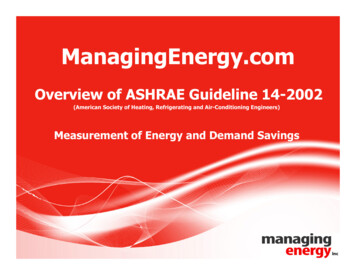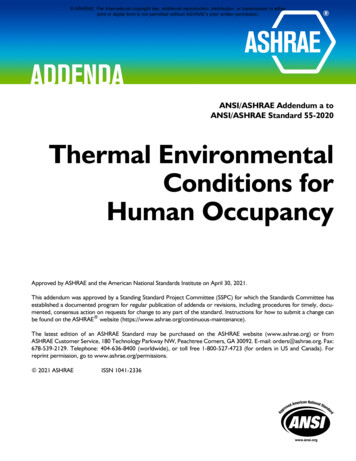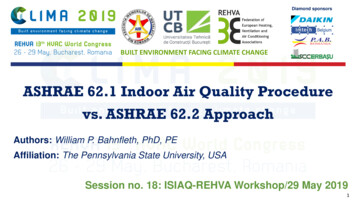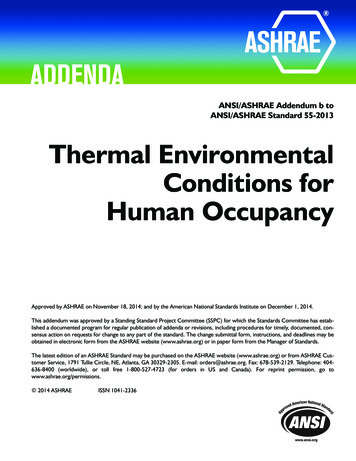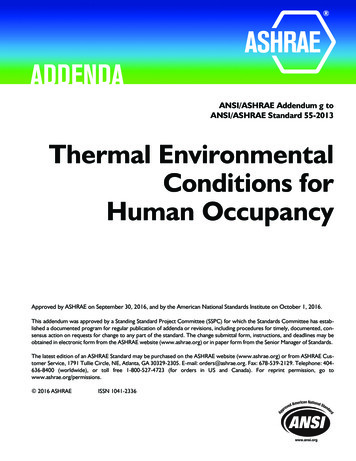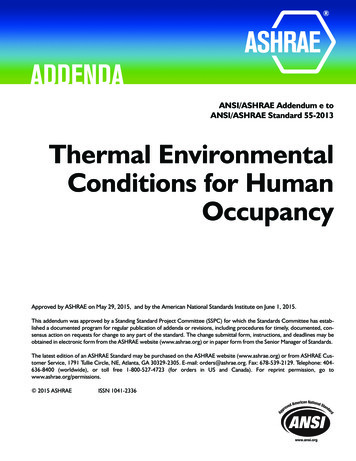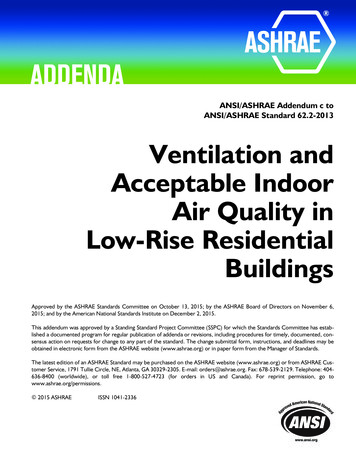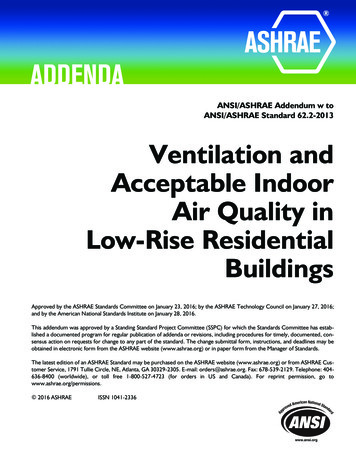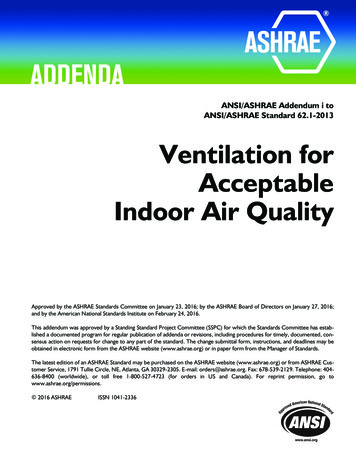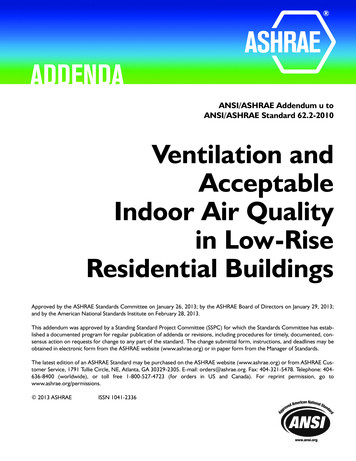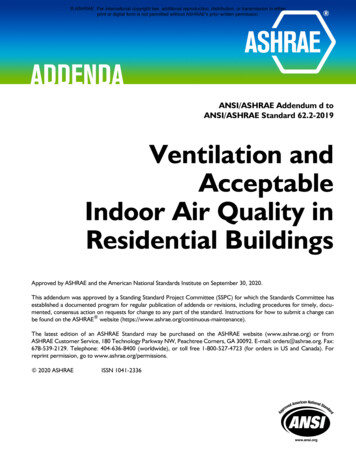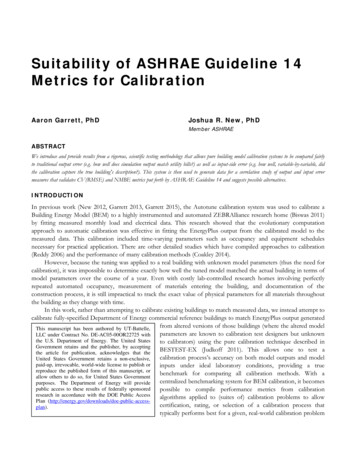
Transcription
Suitability of ASHRAE Guideline 14Metrics for CalibrationAaron Garrett, PhDJoshua R. New, PhDMember ASHRAEABSTRACTWe introduce and provide results from a rigorous, scientific testing methodology that allows pure building model calibration systems to be compared fairlyto traditional output error (e.g. how well does simulation output match utility bills?) as well as input-side error (e.g. how well, variable-by-variable, didthe calibration capture the true building's description?). This system is then used to generate data for a correlation study of output and input errormeasures that validates CV(RMSE) and NMBE metrics put forth by ASHRAE Guideline 14 and suggests possible alternatives.INTRODUCTIONIn previous work (New 2012, Garrett 2013, Garrett 2015), the Autotune calibration system was used to calibrate aBuilding Energy Model (BEM) to a highly instrumented and automated ZEBRAlliance research home (Biswas 2011)by fitting measured monthly load and electrical data. This research showed that the evolutionary computationapproach to automatic calibration was effective in fitting the EnergyPlus output from the calibrated model to themeasured data. This calibration included time-varying parameters such as occupancy and equipment schedulesnecessary for practical application. There are other detailed studies which have compiled approaches to calibration(Reddy 2006) and the performance of many calibration methods (Coakley 2014).However, because the tuning was applied to a real building with unknown model parameters (thus the need forcalibration), it was impossible to determine exactly how well the tuned model matched the actual building in terms ofmodel parameters over the course of a year. Even with costly lab-controlled research homes involving perfectlyrepeated automated occupancy, measurement of materials entering the building, and documentation of theconstruction process, it is still impractical to track the exact value of physical parameters for all materials throughoutthe building as they change with time.In this work, rather than attempting to calibrate existing buildings to match measured data, we instead attempt tocalibrate fully-specified Department of Energy commercial reference buildings to match EnergyPlus output generatedfrom altered versions of those buildings (where the altered modelThis manuscript has been authored by UT-Battelle,parameters are known to calibration test designers but unknownLLC under Contract No. DE-AC05-00OR22725 withthe U.S. Department of Energy. The United Statesto calibrators) using the pure calibration technique described inGovernment retains and the publisher, by acceptingBESTEST-EX (Judkoff 2011). This allows one to test athe article for publication, acknowledges that thecalibration process’s accuracy on both model outputs and modelUnited States Government retains a non-exclusive,paid-up, irrevocable, world-wide license to publish orinputs under ideal laboratory conditions, providing a truereproduce the published form of this manuscript, orbenchmark for comparing all calibration methods. With aallow others to do so, for United States Governmentcentralized benchmarking system for BEM calibration, it becomespurposes. The Department of Energy will providepublic access to these results of federally sponsoredpossible to compile performance metrics from calibrationresearch in accordance with the DOE Public Accessalgorithms applied to (suites of) calibration problems to allowPlan ification, rating, or selection of a calibration process thatplan).typically performs best for a given, real-world calibration problem
and accompanying data.Trinity TestingOn July 16, 1945, the United States tested the detonation of the first nuclear weapon ever created. One of the chiefscientists involved in the project, J. Robert Oppenheimer, named the test “Trinity” which was designed to fullydetermine the efficacy of any nuclear explosive device. In this work, the name “Trinity” is adopted as a convenientterm to refer to the implemented testing framework that can determine the effectiveness of any (automatic or manual)building model calibration system which quantifies the accuracy in terms of input-side error metrics. The calibrationtechnique underlying the “Trinity test” system was first developed and named the “pure calibration test method” byRon Judkoff from the National Renewable Energy Laboratory (NREL) as part of BESTEST-EX (Judkoff 2011). The“Trinity test”' name was first used in relation to BEM calibration by Amir Roth, the Department of Energy’s (DOE)Building Technologies Office technology manager overseeing this project. The Trinity test system has been deployedfor public use at http://bit.ly/trinity test.The Trinity test framework is designed to deal with common issues inherent in auto-calibration results: Most calibrations in the literature are carried out on specific, unique buildings of interest. Building data oftenis not shared, which complicates any attempt by other investigators to duplicate the work. Researchers often report the results of their calibrations in different ways using different metrics, and nearlyall results detail only the model output. If a real building is used, then exact components of the building arelikely unknown, which is precisely why automatic calibration is needed. This leads to a proliferation in theliterature of necessarily unique, largely irreplicable, and essentially incomparable results that do not helpmature the state of the art in automatic calibration approaches.A solution to all of these problems is to test calibration approaches using modified benchmark models. Forinstance, a given Department of Energy commercial reference building has a fully specified EnergyPlus model, whichproduces noise-free output (e.g. no real-world calibration drift or other uncertainty for measured data, and no gapbetween the simulation algorithms versus real-world physics) when passed through EnergyPlus. Using such a modelas a base model, a controlled test model can be created where certain variables of the base are modified within somespecified bounds (e.g., within 30% of the base value). By selecting a valid value for each of the input parameters, atest creator can define what we refer to as the “true model”. The true model can be passed through EnergyPlus toproduce similar noise-free output which functions as a surrogate for clean sensor data. Then, anyone interested intesting a calibration approach can simply retrieve the base model, including names and ranges of the modifiedvariables, and the true model's EnergyPlus output.Ideally, a calibration procedure would be able to discover the (hidden) input variable values of the true model inaddition to producing very similar EnergyPlus output with the calibrated model. Thus, the calibration system'seffectiveness can then be measured exactly by its error in the input domain (true vs. calibrated variable values) andoutput domain (true vs. calibrated model EnergyPlus output). In the context of the Trinity test system, we use“calibration” primarily in comparison to output of a reference simulation as a surrogate to measured data, whichvaries slightly from ASHRAE Guideline 14 definition (b) of calibration “process of reducing the uncertainty of amodel by comparing the predicted output of the model under a specific set of conditions to the actual measured data forthe same set of conditions.”The Trinity test system is illustrated in Figure 1. Here, the base model and true output are given to the Calibrator,while the true model is maintained privately by the Evaluator. The Calibrator would benefit from having the namesand valid ranges of the variables which should be calibrated, and these elements are provided as separate files orwithin an XML version of an EnergyPlus input file. The Evaluator, by having the actual, fully-specified, true model,
can assess not only the accuracy of the predicted model output, but it can also assess the accuracy of the predictedmodel's variables to the true, hidden variables.Figure 1. Trinity Test System. The Test Creator produces a base model, weather file, and schedule (optional) along with amodel that constitutes the “true” model. This true model can be automatically generated and has a setting foreach input parameter that obeys the ranges, distributions, and mathematical constrains specified for tunableparameters in the base model. These files are given to the Evaluator when the test is created, at which time theEvaluator produces the true output generated by the true model. The Calibrator selects a test from theEvaluator and receives the base model, weather, schedule, and true output. The Calibrator then performs thetuning to produce a predicted model, which is submitted to the Evaluator for evaluation. The Evaluatorcompares the predicted model to the true model, both in input and output, and returns the results in the formof aggregated statistics that quantify the Calibrator's accuracy at recovering the true model.Trinity Test Limitations. It should be pointed out that while Trinity testing is a scalable, automated methodologythat does not require extensive manual labor for measuring and maintaining a real-world experimental facility, it hasmany limitations – some of which we discuss below.First, the use of a simulation alone (EnergyPlus in this case) means all noise has been removed from the system.Practical issues such as sensor drift, model-form uncertainty due to algorithmic inaccuracies, missing values fromutility bills (or sensors), different dates of utility bill measurements, and other complications faced by a calibrationmethodology employed in practical use are not captured in this testing methodology. The Trinity test could beextended to allow systematic exploration of calibration inaccuracies caused by such normal phenomena bysystematically adding noise and missing values to EnergyPlus output prior to calibration. To identify model-formuncertainty inaccuracies that arise in differences between a simulation engine’s algorithms and real-world physics, theinterested reader is referred to the BESTEST-EX building physics test suites (Judkoff 2011).Second, a specific weather file is used to define environmental conditions. While our implementation allows atest creator to provide the weather data, this is most frequently Typical Meteorology Year (TMY) data. For real-worldapplication, Actual Meteorological year (AMY) weather data should be used for the time period during which utilitybills and/or sensor data was collected. Previous research has shown that annual energy consumption can vary by 7%and monthly building loads by 40% based solely on which weather vendor provides the AMY data (Bhandari2012).Third, there is not always an intuitive mapping between a point-measurement in a real building and anEnergyPlus output. As an example, a wall in EnergyPlus reports its average temperature but stratification of thermalgradients in an actual building would require either a precise sensor location or processing of a series of temperaturesto correspond with what EnergyPlus reports as the interior or exterior temperature of a given wall. Optionally, a small
sub-wall at the sensor location can be created in the EnergyPlus model, as the authors used in the ZEBRAlliancecalibration, but this drives up runtime and is not currently automated through use of sensor location data.Fourth, real-world measurements are best taken with NIST-calibrated sensors in ways that adhere to knownstandards. As an example, heat flux measurements from a surface are usually taken according to ASTM E2684, whichrequires an appropriate sensor to be measured under a thin layer of the material to ensure the presence of the sensordoesn’t disrupt the temperature and continuity of the material. As of the time of this writing, a new feature is beingconsidered for EnergyPlus that would allow it to be compared in validation studies where heat flux transducers arethroughout a multi-layer envelope assembly (e.g., a wall). Exquisite care in measurement, as well as extensions to thesimulation engine itself, is often necessary to allow a proper comparison.Fifth, all inputs are treated equally and aggregate metrics (to limit gaming) are provided for input-side error.Trinity testing does not incorporate domain-specific information that some inputs matter more than others when itcomes to the effect on whole-building energy consumption or given model use case (e.g. optimal retrofit). Being aclean-room methodology which does not address real-world complications (sensor drift, missing measured data, lackof measurement correspondence with simulation output, inaccurate algorithms, etc.) it does not necessarily follow thata calibration methodology which performs well under Trinity test conditions is field-deployable.Automated Web ServiceThe Trinity testing framework, as presented above, requires a strict protocol. The Calibrator must never beexposed to the true model, which should remain private along with any information that might be used to infer thevalues of those hidden variables. Therefore, the Calibrator is entirely dependent upon the Evaluator to assess theaccuracy of the calibration process (since only the evaluator has access to the true model). This requires a great deal ofeffort from the Evaluator, which is a limitation of the methodology. To alleviate this, the Trinity testing frameworkhas been automated by converting it into a web service.The functionality of the Trinity service consists of four actions:1. Create a test case2. Download a test case3. Evaluate a calibrated model4. Download evaluation resultsA user would invoke their calibration procedure—which could be manual, semi-automatic, or fully automated—between steps 2 and 3. Each of these four Trinity test actions in the workflow is described in more detail in thefollowing subsections.Test Creation. A test case is created when a user (whic
Suitability of ASHRAE Guideline 14 Metrics for Calibration. Aaron Garrett, PhD Joshua R. New, PhD . Member ASHRAE . ABSTRACT . We introduce and provide results from a rigorous, scientific testing methodology that allows pure building model calibration systems to be compared fairly
